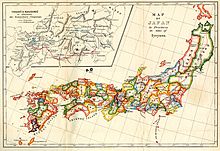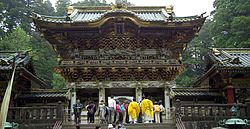
Back شوغونية توكوغاوا Arabic Shogunato Tokugawa AST Tokuqava şoqunluğu Azerbaijani توکوقاوا سولالهسی AZB Токугава сёгунаты Bashkir Shogunato kan Tokugawa BCL Сёгунат Такугава Byelorussian Шогунат Токугава Bulgarian Tokugawa BS Shogunat Tokugawa Catalan
Tokugawa shogunate
| |||||||||||||
|---|---|---|---|---|---|---|---|---|---|---|---|---|---|
| 1603–1868 | |||||||||||||
Mon of the Tokugawa clan
| |||||||||||||
| National seal 經文緯武  (from 1857) | |||||||||||||
 | |||||||||||||
| Capital | Edo (Shōgun's residence) Heian-kyō (Emperor's palace) | ||||||||||||
| Largest city | Osaka (1600–1613) Heian-kyō (1613–1638) Edo (1638–1868) | ||||||||||||
| Common languages | Early Modern Japanese[1] Modern Japanese[1] | ||||||||||||
| Religion | State religions: Japanese Buddhism[2] Confucianism[3] Others: Shinto[3] Shinbutsu-shūgō[4] Japanese Buddhism[5] Christianity[6] (banned, until 1853)[3] | ||||||||||||
| Government | Feudal[7] dynastic[8] hereditary military dictatorship[9][10] | ||||||||||||
| Emperor | |||||||||||||
• 1600–1611 (first) | Go-Yōzei[11] | ||||||||||||
• 1867–1868 (last) | Meiji[12] | ||||||||||||
| Shōgun | |||||||||||||
• 1603–1605 (first)[13] | Tokugawa Ieyasu | ||||||||||||
• 1866–1868 (last) | Tokugawa Yoshinobu | ||||||||||||
| Historical era | Edo period | ||||||||||||
| 21 October 1600[14] | |||||||||||||
| 8 November 1614 | |||||||||||||
| 1635 | |||||||||||||
| 31 March 1854 | |||||||||||||
| 29 July 1858 | |||||||||||||
| 3 January 1868[15] | |||||||||||||
| Currency | The tri-metallic Tokugawa coinage system based on copper Mon, silver Bu and Shu, as well as gold Ryō. | ||||||||||||
| |||||||||||||
| Today part of | Japan | ||||||||||||
| Part of a series on the |
| History of Japan |
|---|
 |
The Tokugawa shogunate (/ˌtoʊkuːˈɡɑːwə/ TOHK-oo-GAH-wə;[17] Japanese: 徳川幕府, romanized: Tokugawa bakufu, IPA: [tokɯgawa, tokɯŋawa baꜜkɯ̥ɸɯ]), also known as the Edo shogunate (江戸幕府, Edo bakufu), was the military government of Japan during the Edo period from 1603 to 1868.[18][19][20]
The Tokugawa shogunate was established by Tokugawa Ieyasu after victory at the Battle of Sekigahara, ending the civil wars of the Sengoku period following the collapse of the Ashikaga shogunate. Ieyasu became the shōgun, and the Tokugawa clan governed Japan from Edo Castle in the eastern city of Edo (Tokyo) along with the daimyō lords of the samurai class.[21][22][19] The Tokugawa shogunate organized Japanese society under the strict Tokugawa class system and banned most foreigners under the isolationist policies of Sakoku to promote political stability. The Tokugawa shoguns governed Japan in a feudal system, with each daimyō administering a han (feudal domain), although the country was still nominally organized as imperial provinces. Under the Tokugawa shogunate, Japan experienced rapid economic growth and urbanization, which led to the rise of the merchant class and Ukiyo culture.
The Tokugawa shogunate declined during the Bakumatsu period from 1853 and was overthrown by supporters of the Imperial Court in the Meiji Restoration in 1868. The Empire of Japan was established under the Meiji government, and Tokugawa loyalists continued to fight in the Boshin War until the defeat of the Republic of Ezo at the Battle of Hakodate in June 1869.
- ^ a b Shibatani, Masayoshi. "Japanese language | Origin, History, Grammar, & Writing". britannica.com. Encyclopædia Britannica, Inc. Archived from the original on January 31, 2020. Retrieved June 15, 2021.
- ^ Yamagishi, Keiko (2016). Ferrari, Silvio; Cristofori, Rinaldo (eds.). Law and Religion, An Overview. Vol. 1. Routledge. p. 458. ISBN 978-1-4094-3600-3. Archived from the original on 31 May 2023. Retrieved 31 May 2023.
The Tokugawa Shogunate had sanctioned Buddhism as a state religion.
- ^ a b c Calabresi, Steven Gow (2021). The History and Growth of Judicial Review. Vol. 2. Oxford University Press. p. 116. ISBN 9780190075750. Archived from the original on 31 May 2023. Retrieved 31 May 2023.
A dew sexteenth-century Chiristian missionaries left a small following in Japan, but from 1600 until 1853, the countory was governed by the Tokugawa Shogunate banned Christianity, forbade travel overseas, and only allowed foreign trade in the port of Nagasaki with the Netherlands and China. Confucianism, with its emphasis on harmony, was the prevailing "state religion", although it coexisted with Shintoism, a religion that worshipped nature gods and that was personified by the emperor.
- ^ Hirai, Naofusa. "Shinto § The encounter with Buddhism". britannica.com. Encyclopædia Britannica, Inc. Archived from the original on August 11, 2023. Retrieved June 15, 2021.
Buddhistic Shintō was popular for several centuries and was influential until its extinction at the Meiji Restoration.
- ^ Tucci, Giuseppe. "Buddhism - Korea and Japan". britannica.com. Encyclopædia Britannica, Inc. Archived from the original on October 13, 2022. Retrieved June 15, 2021.
- ^ "Kirishitan | religion". britannica.com. Encyclopædia Britannica, Inc. Archived from the original on May 3, 2021. Retrieved June 15, 2021.
- ^ Cite error: The named reference
britannicawas invoked but never defined (see the help page). - ^ "Japan § Introduction". The World Factbook. Central Intelligence Agency. Archived from the original on 5 January 2021. Retrieved 9 March 2021.
- ^ "Shogunate". britannica.com. Encyclopædia Britannica, Inc. Archived from the original on October 9, 2020. Retrieved October 21, 2020.
The shogunate was the hereditary military dictatorship of Japan (1192–1867).
- ^ "Tokugawa period". britannica.com. Encyclopædia Britannica, Inc. Archived from the original on July 24, 2019. Retrieved June 3, 2020.
- ^ Emperor Go-Yōzei started reigning in 1586, after the abdication of Emperor Ōgimachi.
- ^ Emperor Meiji reigned until his death in 1912.
- ^ "Tokugawa Ieyasu JapanVisitor Japan Travel Guide". Archived from the original on 2021-04-18. Retrieved 2021-05-28.
- ^ "The Story of the Battle of Sekigahara". Archived from the original on 2021-05-16. Retrieved 2021-05-28.
- ^ "meiji-restoration Tokugawa Period and Meiji Restoration". Retrieved 2021-05-28.
- ^ "Daimyo Flags, 19th Century". Flags of the World. Archived from the original on 2022-09-20. Retrieved 2022-09-15.
- ^ "Tokugawa". Lexico UK English Dictionary. Oxford University Press. Archived from the original on November 28, 2020.
- ^ Nussbaum 2002, p. 978
- ^ a b Nussbaum 2002, p. 167
- ^ Nussbaum 2002, p. 525
- ^ Nussbaum 2002, pp. 878–879
- ^ Nussbaum 2002, p. 976
